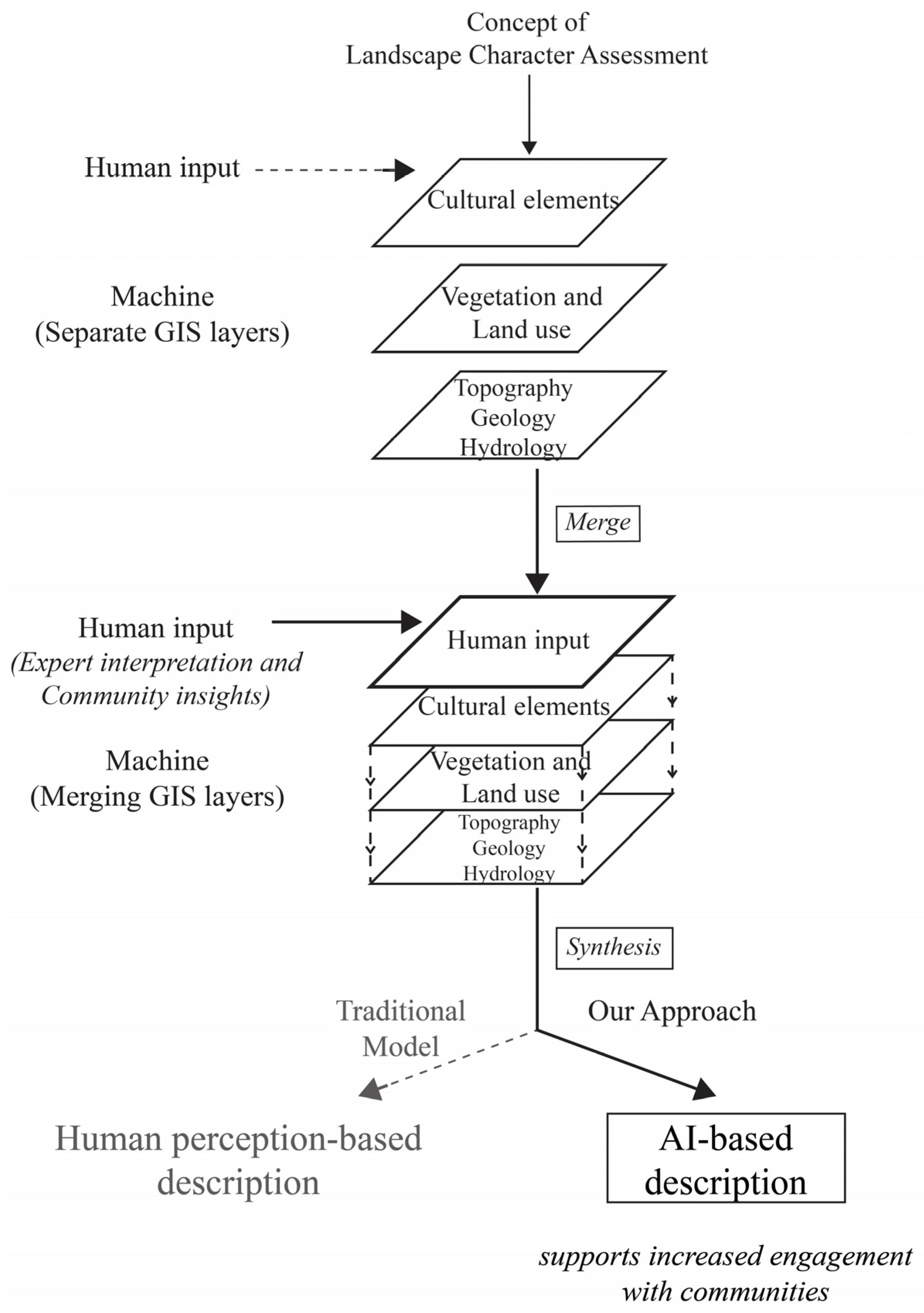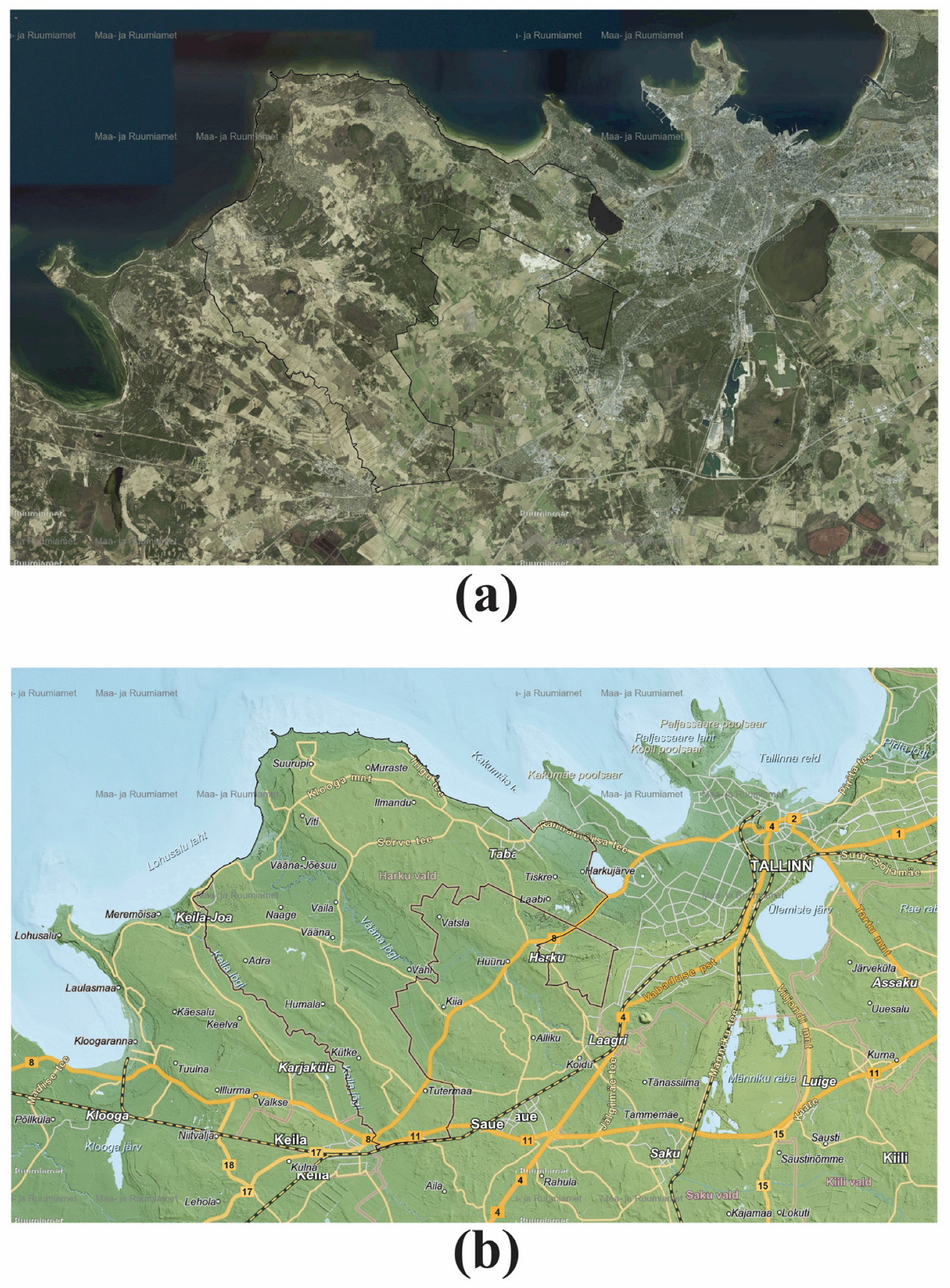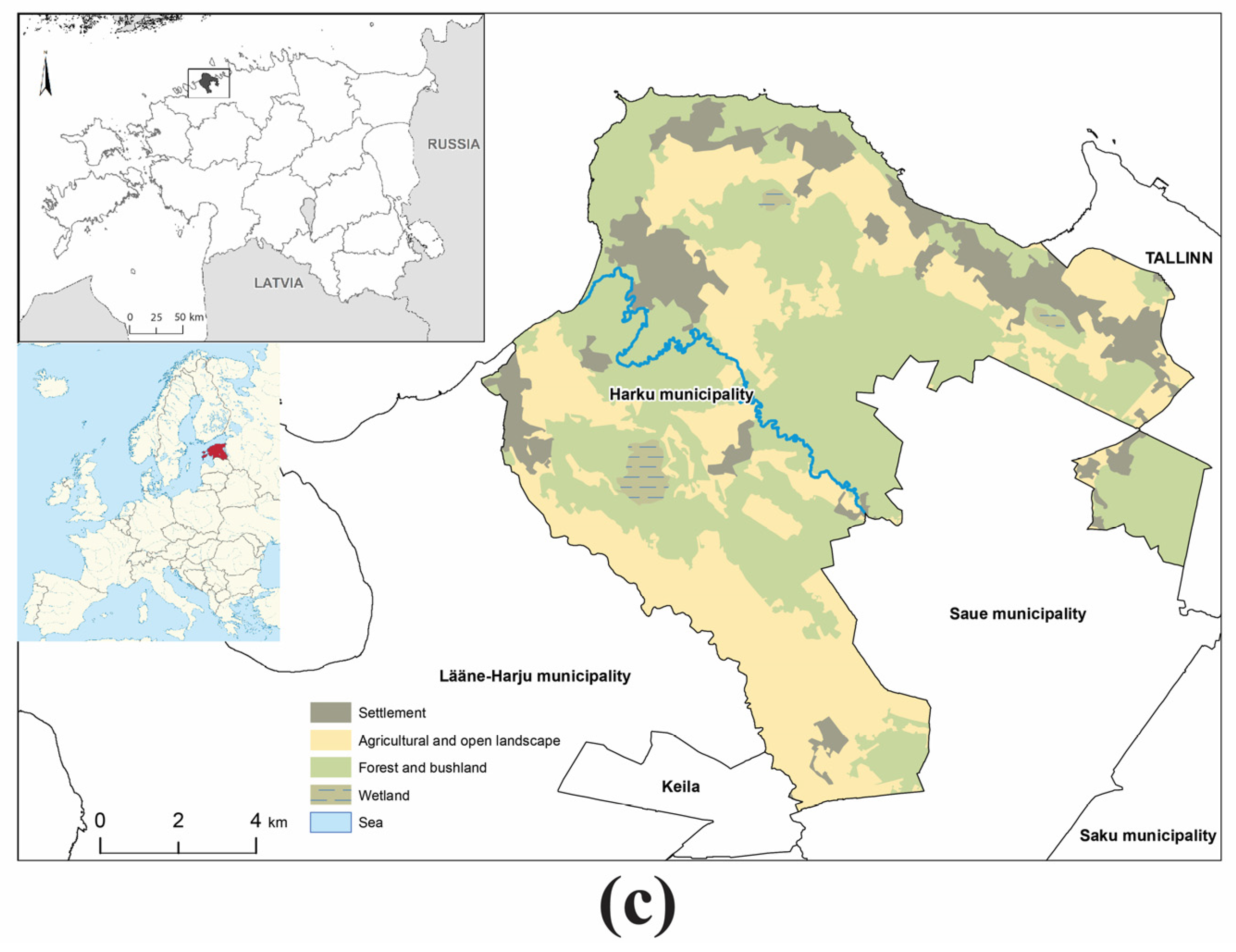AI-Assisted Landscape Character Assessment: A Structured Framework for Text Generation, Scenario Building, and Stakeholder Engagement Using ChatGPT
Abstract
1. Introduction and Background
1.1. The Role of Textual Descriptions in LCA
1.2. Artificial Intelligence in the Landscape Domain
1.3. GenAI in Landscape Practice and Education
1.4. Research Gap
1.5. Research Aims and Questions
- Design and test a structured workflow involving data input, prompt formulation, LCA description templates, scenario building, and the simulation of stakeholder perspectives through role play.
- Assess the consistency and reliability of outputs generated by ChatGPT across multiple runs.
- Reflect on the educational and planning relevance of this method.
- Can ChatGPT generate relevant and coherent textual descriptions of landscape character areas when provided with a structured input?
- How consistent are the results across repeated queries using the same prompt and data?
- Can the use of ChatGPT be extended beyond descriptive tasks to support scenario-based foresight and simulate diverse stakeholder perspectives?
2. Materials and Methods
2.1. Study Area
Study Area—Harku Municipality, Estonia
2.2. Framework for ChatGPT-Assisted LCA Text Generation
2.3. Scenario Building Through Integrating a Local Development Plan
2.4. Reliability Assessment of the ChatGPT-Assisted LCA Text Generation
2.5. Stakeholder Role Play Perspective
3. Results
3.1. Overall Consistency
3.1.1. Language Differences and Similarities Across the Authors’ Outputs from ChatGPT
3.1.2. Content Accuracy
3.2. Scenarios
3.3. Stakeholder Role Play
4. Discussion
4.1. Reflections on Language Differences and Similarities in ChatGPT Outputs
4.2. Opportunities and Added Value of Using AI in LCA
4.3. Limitations and Risks of ChatGPT-Assisted LCA
4.4. Technical Reliability and the Role of Expert Knowledge
4.5. Time Efficiency and Human Relationships in the Shadow of AI-Assisted LCA
4.6. Limitations, Opportunities, and Future Directions
5. Conclusions
6. Recommendations
Supplementary Materials
Author Contributions
Funding
Data Availability Statement
Acknowledgments
Conflicts of Interest
Abbreviations
| LCA | Landscape Character Assessment |
| LCI | Landscape Character Identification |
| AI | Artificial Intelligence |
| GenAI | Generative Artificial Intelligence |
| ELC | European Landscape Convention |
References
- Sauer, C.O. Morphology of Landscape; University of California Press: Berkeley, CA, USA, 1925; Available online: https://www.scribd.com/doc/256866389/Sauer-1925-Morphology-of-Landscape (accessed on 28 July 2025).
- McHarg, I.L. Design with Nature; Wiley: Hoboken, NJ, USA, 1969. [Google Scholar]
- Fairclough, G.; Herlin, I.S.; Swanwick, C. (Eds.) Routledge Handbook of Landscape Character Assessment: Current Approaches to Characterisation and Assessment, 1st ed.; Routledge: London, UK, 2018; Available online: https://www.routledge.com/Routledge-Handbook-of-Landscape-Character-Assessment-Current-Approaches-to-Characterisation-and-Assessment%20/Fairclough-SarlovHerlin-Swanwick/p/book/9780367502171 (accessed on 28 July 2025).
- Swanwick, C. Landscape Character Assessment: Guidance for England and Scotland-Topic Paper 1: Recent Practice and the Evolution of Landscape Character Assessment; Scottish Natural Heritage: Edinburgh, UK; The Countryside Agency: Cheltenham, UK, 2002. Available online: https://www.parcopopiemontese.it/documenti/paesaggio/dwd/lineeguida/lca.pdf (accessed on 28 July 2025).
- Bell, S. Landscape pattern, perception and visualisation in the visual management of forests. Landsc. Urban Plan. 2011, 54, 201–211. Available online: https://www.sciencedirect.com/science/article/pii/S0169204601001360 (accessed on 28 July 2025). [CrossRef]
- Bell, S. Landscape: Pattern, Perception and Process; Routledge: London, UK, 2012; Available online: https://www.taylorfrancis.com/books/mono/10.4324/9780203120088/landscape-pattern-perception-process-simon-bell (accessed on 28 July 2025).
- Council of Europe. Council of Europe Landscape Convention; Council of Europe: Strasbourg, France, 2002; Available online: https://rm.coe.int/16807b6bc7 (accessed on 15 December 2024).
- Wascher, D.M. European Landscape Character Areas: Typologies, Cartography and Indicators for the Assessment of Sustainable Landscapes; Landscape Europe: Wageningen, The Netherlands, 2005; Available online: https://library.wur.nl/WebQuery/wurpubs/reports/376380 (accessed on 28 July 2025).
- Baas, H.; Groenewoudt, B.; Raap, E. The Dutch Approach. In The European Landscape Convention; Jones, M., Stenseke, M., Eds.; In Landscape Series; Springer: Dordrecht, The Netherlands, 2011; pp. 45–66. [Google Scholar] [CrossRef]
- Nijhuis, S.; Reitsma, M. Landscape policy and visual landscape assessment. Res. Urban. Ser. 2011, 2, 229–259. [Google Scholar] [CrossRef]
- Bruns, D.; Stemmer, B. Landscape assessment in Germany. In Routledge Handbook of Landscape Character Assessment; Routledge: London, UK, 2018. [Google Scholar]
- Franchi, A.; Raymond, R.; Luginbühl, Y.; Seguin, J.-F.; Grare, H. Méthode Pour L’identification, la Caractérisation et la Qualification des Paysages; Ministère de l’Écologie, du Développement Durable et de l’Énergie: La Défense, France, 2015.
- Kurs, O. Elusid ja Eluruume. In Ilmatargad; Ilmamaa: Tartu, Estonia, 2009. [Google Scholar]
- Granö, J.G. Eesti Maastikulised Üksused; Regio: Tartu, Estonia, 1922. [Google Scholar]
- Granö, J.G. Maastikuteaduse Ülesanded ja Maastiku Vormide Süsteem. Acta Comment. Univ. Tartu. Dorpat. 1924. Available online: https://dspace.ut.ee/items/a242a514-08f2-477a-9db3-eebf418f38b2 (accessed on 28 July 2025).
- Kant, E.; Kurs, O.; Runnel, S.; Ombler, S. Eesti Rahvastik ja Asustus; Ilmamaa: Tartu, Estonia, 2007. [Google Scholar]
- Kant, E. Linnad ja maastikud; Ilmamaa: Tartu, Estonia, 1999; Available online: https://www.vanaraamat.ee/Edgar_Kant_Koostanud_ja_jarelsona_Ott_Kurs_Linnad_ja_maastikud_Ilmamaa_1999_35524-21.htm (accessed on 29 July 2025).
- Tammiksaar, E.; Pae, T.; Kurs, O. A continuity of ideas? salme nõmmik, edgar kant and the development of economic geography in soviet Estonia. Geogr. Ann. Ser. B Hum. Geogr. 2013, 95, 51–70. [Google Scholar] [CrossRef]
- Pae, T. Formation of Cultural Traits in Estonia Resulting from Historical Administrative Division; Tartu University Press: Tartu, Estonia, 2006; Available online: https://dspace.ut.ee/bitstreams/f30f06a2-984c-4e7f-89e9-bb22ef4e38e0/download (accessed on 29 July 2025).
- Nevzati, F.; Veldi, M.; Külvik, M.; Bell, S. Analysis of Landscape Character Assessment and Cultural Ecosystem Services Evaluation Frameworks for Peri-Urban Landscape Planning: A Case Study of Harku Municipality, Estonia. Land 2023, 12, 1825. [Google Scholar] [CrossRef]
- Tudor, C. An Approach to Landscape Character Assessment. 2014. Available online: https://assets.publishing.service.gov.uk/media/5aabd31340f0b64ab4b7576e/landscape-character-assessment.pdf (accessed on 29 July 2025).
- Terkenli, T.; Gkoltsiou, A.; Kavroudakis, D. The Interplay of Objectivity and Subjectivity in Landscape Character Assessment: Qualitative and Quantitative Approaches and Challenges. Land 2021, 10, 53. [Google Scholar] [CrossRef]
- Alkhateeb, G.; Storie, J.; Külvik, M. Post-Conflict Urban Landscape Storytelling: Two Approaches to Contemporary Virtual Visualisation of Oral Narratives. Land 2024, 13, 406. [Google Scholar] [CrossRef]
- Alkhateeb, G.; Storie, J.; Bell, S.; Suškevičs, M. Virtual Imaginative Geographies: Generative AI and the Representation of Landscape Imagery. Geographies 2025, 5, 9. [Google Scholar] [CrossRef]
- Kim, J.; Lee, Y. Accuracy Evaluation of Tree Images Created Using Generative Artificial Intelligence. J. Digit. Landsc. Archit. 2024, 2024, 1029–1037. [Google Scholar] [CrossRef]
- Liu, X. Integrating Generative AI into Landscape Architecture Education: Methodologies, Applications, and Ethical Considerations. J. Digit. Landsc. Archit. 2024, 2024, 937–945. [Google Scholar] [CrossRef]
- Zwangsleitner, F.; Habjanič, G.; Knegendorf, A. AI as a Tool in the Landscape Architecture Design Process. J. Digit. Landsc. Archit. 2024, 2024, 987–994. [Google Scholar] [CrossRef]
- Fernberg, P.; George, B.H.; Chamberlain, B. Producing 2D Asset Libraries with AI-powered Image Generators. J. Digit. Landsc. Archit. 2023, 2023, 186–194. [Google Scholar] [CrossRef]
- Huang, T.; Zhao, H.; Huang, B.; Li, S.; Zhu, J. Integrating Natural Language Processing With Vision Transformer for Landscape Character Identification. IEEE J. Sel. Top. Appl. Earth Obs. Remote Sens. 2025, 18, 5838–5852. [Google Scholar] [CrossRef]
- Qin, W.; Li, W.; Zhang, Z.; Chen, W.; Wan, M. Landscape Character Classification with a Deep Neural Network: A Case Study of the Jianghan Plain. Land 2024, 13, 2024. [Google Scholar] [CrossRef]
- Ho, L.-C. LaDeco: A tool to analyze visual landscape elements. Ecol. Inform. 2023, 78, 102289. [Google Scholar] [CrossRef]
- Hicks, M.T.; Humphries, J.; Slater, J. ChatGPT is bullshit. Ethics Inf. Technol. 2024, 26, 38. [Google Scholar] [CrossRef]
- Nevzati, F. Evaluating Ecosystem Services and Their Impact on Human Well-Being in the Peri-Urban Landscape of Harku Municipality, Estonia. Ph.D. Thesis, Estonian University of Life Sciences, Tartu, Estonia, 2024. [Google Scholar] [CrossRef]
- Savilaakso, S.; Burgas, D.; Cantú, I.; Cassidy, E.; Dix, G.; Ekroos, J.; Green, E.; Hua, F.; Klimas, C.; Krishnan, S.; et al. State of Knowledge Regarding How We Can Improve Adherence to the Mitigation Hierarchy, with a Particular Focus on the Avoid Stage; Zenodo-CERN: Geneva, Switzerland, 2023. [Google Scholar] [CrossRef]
- Reddy, K.; Janga, J.K. Utilization of Generative Artificial Intelligence in Geotechnical and Geoenvironmental Engineering; Springer Nature: Singapore, 2025. [Google Scholar] [CrossRef]
- European Union. Artificial Intelligence Act; Publications Office of the European Union: Luxembourg, 2023; Volume P9_TA(2023)0236. Available online: https://eur-lex.europa.eu/legal-content/EN/TXT/HTML/?uri=CELEX%3A52023AP0236 (accessed on 4 September 2025).
- Floridi, L.; Cowls, J. A Unified Framework of Five Principles for AI in Society. Harv. Data Sci. Rev. 2019, 1, 1–15. [Google Scholar] [CrossRef]
- OpenAI. OpenAI: Terms of Use. Available online: https://openai.com/en-GB/policies/row-terms-of-use/ (accessed on 3 September 2025).
- UNDP. Hamburg Declaration on Responsible Artificial Intelligence (AI) for the Sustainable Development Goals (SDGs); UNDP: New York, NY, USA, 2025; Available online: https://www.bmz-digital.global/wp-content/uploads/2025/06/250603_Hamburg_Declaration.pdf (accessed on 29 July 2025).
- Butler, A. Dynamics of integrating landscape values in landscape character assessment: The hidden dominance of the objective outsider. Landsc. Res. 2016, 41, 239–252. [Google Scholar] [CrossRef]
- Calderon, C.; Butler, A. Politicising the landscape: A theoretical contribution towards the development of participation in landscape planning. Landsc. Res. 2020, 45, 152–163. [Google Scholar] [CrossRef]
- Butler, A.; Berglund, U. Landscape Character Assessment as an Approach to Understanding Public Interests within the European Landscape Convention. Landsc. Res. 2014, 39, 219–236. [Google Scholar] [CrossRef]
- Harku Municipality. Harku Valla Arengukava 2025–2040. 2022. Available online: https://www.riigiteataja.ee/aktilisa/4081/1202/4038/vvk_2024_m_12_Lisa_3.pdf (accessed on 29 July 2025).
- Arold, I. Eesti Maastikud; Tartu Ülikooli Kirjastus: Tartu, Estonia, 2005; Available online: http://hdl.handle.net/10062/16805 (accessed on 29 July 2025).
- Worcestershire County Council. Landscape Character Assessment Supplementary Guidance Technical Handbook. 2013. Available online: https://gis.worcestershire.gov.uk/website/LandscapeCharacter/Documents/lca%20th.pdf (accessed on 29 July 2025).
- Estonian Land Board. Geoportal|Estonian Land and Spatial Development Board. Available online: https://geoportaal.maaamet.ee/eng/ (accessed on 29 July 2025).






| LCA Component | Terminology Variation | Example Terms (Specific vs. Broad) |
|---|---|---|
| Landform and Topography | Strong | “gentle slopes” vs. “hilly terrain” |
| Land Use and Land Cover | Moderate | “agricultural areas”, “mixed-use”, etc. |
| Vegetation | Strong | “mixed coniferous woodland” vs. “tree-covered area” |
| Settlement Patterns | Strong | “uninhabited”, “ribbon development”, “minimal development” |
| Perceptual Qualities | Very strong | “open views to the coast” vs. “limited visual access” |
| Scenario Type | Common Themes Across All Responses | Variation in Thematic Focus |
|---|---|---|
| Worst-Case | Uncontrolled development, environmental degradation, cultural landscape loss | Traditional land use loss, visual degradation, urban sprawl, habitat fragmentation |
| Zero-Change | Continuation of existing patterns, lack of intervention, stable but stagnant landscape conditions | Socio-political stagnation, missed ecological opportunities, neutral landscape trajectory |
| Best-Case | Sustainable growth, ecological integration, cultural sensitivity, improved planning coordination | Nature-based solutions, cultural revitalisation, mobility enhancement, spatial zoning reform |
| Stakeholder Role | Perceived Value of ChatGPT-Generated Outputs | Concerns Raised |
|---|---|---|
| LCA Specialist | Useful for early-stage drafting; supports education; scenario narratives offer planning foresight | Terminology inconsistency; uneven perceptual/cultural coverage; need for expert review |
| Municipal Planner | Supports early planning discussions; builds shared language; helpful for staff briefings | Language too academic; lacks links to practical planning elements |
| Environmental NGO Representative | Highlights environmental pressures; supports advocacy and awareness | Insufficient biodiversity detail; generalised language may obscure sensitive dynamics |
| Local Community Member | Relatable landscape features; helps visualise future change; useful for consultations | Complex terminology; lacks attention to daily life and lived experiences |
| Landscape Architecture Developer | Informs site context and early design; scenario use in adaptive strategies | Insufficient spatial specificity; needs stronger alignment with design practice |
| Farmers and Landowners | Accurate land use/topography; identifies landscape pressures affecting farming | Limited regulatory focus; subsidy implications not addressed |
| Real Estate Developer | Identifies growth areas; useful for early investment scoping | Descriptions too general; unclear spatial detail; permit alignment unclear |
| Tourism Operator | Identifies scenic potential; reflects visitor-relevant changes | Limited focus on accessibility and recreation infrastructure |
| Cultural Heritage Expert | References historical elements; potential for baseline scoping | Intangible heritage underrepresented; weak heritage risk framing |
| National Authorities | Supports strategic alignment; scenario foresight for spatial policy | Needs better policy language alignment; missing links to national targets |
Disclaimer/Publisher’s Note: The statements, opinions and data contained in all publications are solely those of the individual author(s) and contributor(s) and not of MDPI and/or the editor(s). MDPI and/or the editor(s) disclaim responsibility for any injury to people or property resulting from any ideas, methods, instructions or products referred to in the content. |
© 2025 by the authors. Licensee MDPI, Basel, Switzerland. This article is an open access article distributed under the terms and conditions of the Creative Commons Attribution (CC BY) license (https://creativecommons.org/licenses/by/4.0/).
Share and Cite
Alkhateeb, G.; Veldi, M.; Storie, J.T.; Külvik, M. AI-Assisted Landscape Character Assessment: A Structured Framework for Text Generation, Scenario Building, and Stakeholder Engagement Using ChatGPT. Land 2025, 14, 1842. https://doi.org/10.3390/land14091842
Alkhateeb G, Veldi M, Storie JT, Külvik M. AI-Assisted Landscape Character Assessment: A Structured Framework for Text Generation, Scenario Building, and Stakeholder Engagement Using ChatGPT. Land. 2025; 14(9):1842. https://doi.org/10.3390/land14091842
Chicago/Turabian StyleAlkhateeb, Ghieth, Martti Veldi, Joanna Tamar Storie, and Mart Külvik. 2025. "AI-Assisted Landscape Character Assessment: A Structured Framework for Text Generation, Scenario Building, and Stakeholder Engagement Using ChatGPT" Land 14, no. 9: 1842. https://doi.org/10.3390/land14091842
APA StyleAlkhateeb, G., Veldi, M., Storie, J. T., & Külvik, M. (2025). AI-Assisted Landscape Character Assessment: A Structured Framework for Text Generation, Scenario Building, and Stakeholder Engagement Using ChatGPT. Land, 14(9), 1842. https://doi.org/10.3390/land14091842







